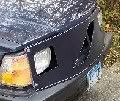|
There are a couple likely causes for this. One is cheap to do (fuse cleaning), the other can be inexpensive to diagnose. If neither of the two below help you out, then you have to consider other possibilities - which I'm sure will be posted by others here soon
First is the 25A blade fuse located in the white fuse holder, behind battery, on inner fender wall. With car OFF, pull the fuse and clean up the contacts using an emery cloth or knife blade or whatever you prefer. If you have some dielectric grease handy, squeeze a bit into the female fuse holder contacts before reinserting the fuse.
IF you decide to get further involved in the fuse holder by replacing it or opening it up the clean the innards (possibly not needed), you MUST pull the battery ground wire first. The blade fuse holder has hot wires going in and out of it which will ground on the fender wall or anything else if you give it half a chance. This makes a BIG POP and is unhealthy for your and your car. So disable the car's electronics if you want to go there. Favorite replacements for the fuse holder seem to come from marine supply houses (waterproof) and Radio Shack (less expensive but durable). I use junker-salvage ones, and clean up the innards at my leisure. The fuse holder opens up by releasing the small tabs on the two sides. Then they're good for another 5-10 years or so, I figure.
Second Possibility is one or both fuel pumps, and the intake tube for the in-tank pump. When fuel tank is lower than 2/3 full or thereabouts, the main pump relies more and more on the in-tank pump to feed it fuel.
The in-tank pumps go bad, leaving the main pump the job of pulling the fuel up out of the bottom of the tank, in addition to sending it forward to the engine under high pressure.
Also, the in-tank pump's pickup hose deteriorates, and gets holes in it. So regardless of which of the two pumps is trying to pull fuel up out of the tank, it's working against those holes that let air get pulled in instead. Like sipping soda through a damaged straw. I think that's the anti-siphon function you mentioned.
One remedy is to keep the tank kinda full, probably at least 1/2. Another is to turn the key to "on" and hear the pump run for a few seconds and then stop. Do this a few times before cranking the motor, and you'll likely prime the system well enough for it to start the first time you do crank it. I admit, I think that different years 240s have slightly different patterns of how long the pump runs when you do this. You likely can hear the pump if you keep the door chime quiet with a finger on that button. In any case, several seconds of "on", then "off", then repeat the cycle a couple times, will likely prime it sufficiently.
The real cure is to get the in-tank pump and pickup hose replaced, but you'll want to diagnose it by trying these remedies first. No sense paying the parts + labor if the cause of your troubles is elsewhere.
Main Pump. Not a likely cause of this. Their failure mode is not exactly what you described. When they fail completely, the car won't run. It needs the 60-80 psi or so of pressure that the main pump produces, or no-go. In-tank pump produces only 4-6 psi or so, to feed the main pump. The partial-failure mode of the main pump is that it won't start, but whacking it's mount area with a wood mallet will often get it going if someone else has the key in the "start" position. Do this with some care of course, there are fuel lines and wires in the same area so you better get a good look at what you're hitting. The pump is on underside of car, in front of the left rear wheel. Get a good look. But as I said earlier, from your description it doesn't sound like a bad main pump. If dead, the car wouldn't run at all. If sick, jarring seems to bring them to life.
Last, I'll mention the fuel pump relay. They also seem to go bad and stay bad, so maybe not the cause of your problem. Pretty easy to replace, and not too pricey. If you can solder, you can open it up and resolder the bad, cracked connections. Relay is located under the glove box. You have to pull some carpeting and under-dash felt out of the way. Relay is about 1x2x3 inches, rectangular, white. Has a bunch of parallel male spade connectors (most Volvo relays have connectors at right angles to each other). Should be clipped to the kick panel under the glove box, but sometimes hangs loose. Use plastic "zip" wire ties to secure it if the clip isn't usable.
--
Sven: '89 245, IPD sways, electric rad. fan conversion, 28+ mpg - auto tranny. 850 mi/week commute. '89 245 #2 (wifemobile). '90 244 (spare, runs).
|
